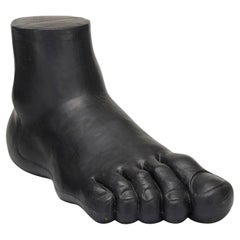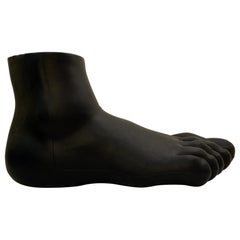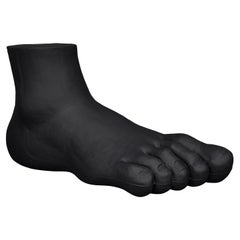Gaetano Pesce Piede
UP7 FOOT Lounge Chair by Gaetano Pesce for B&B Italia - Gran Salotto by Duplex
By B&B Italia, Gaetano Pesce
Located in Brooklyn, NY
In 1969, Gaetano Pesce designed Il Piede (UP7), the final piece in his renowned Up Series, which
Category
21st Century and Contemporary Italian Lounge Chairs
Materials
Foam
$4,500 / item
H 31.5 in W 21 in D 63 in
Recent Sales
Gaetano Pesce, 1969 For B&B Italia "UP-7 Piede" Sculpture Lounge Chair "Foot"
By Gaetano Pesce
Located in Brussels, BE
Gaetano Pesce, 1969 for B&B Italia "UP-7 Piede" sculpture lounge chair "Foot".
Category
Vintage 1960s Italian Lounge Chairs
Materials
Foam
H 19.3 in W 63 in D 34.65 in
Gaetano Pesce Up7 Piede / Foot by B&B Italia, 1969
By Gaetano Pesce, B&B Italia
Located in Pijnacker, Zuid-Holland
Up-7 Piede / Foot by Gaetano Pesce for B&B Italia, designed in 1969.
It is made of polyurethane
Category
Vintage 1960s Italian Mid-Century Modern Lounge Chairs
Materials
Foam
Gaetano Pesce Up7 Piede / Foot by B&B Italia, 1969
By Gaetano Pesce, B&B Italia
Located in Pijnacker, Zuid-Holland
Rare Up-7 Piede / Foot by Gaetano Pesce for B&B Italia, 1969.
It is made of polyurethane foam with
Category
Vintage 1960s Italian Mid-Century Modern Lounge Chairs
Materials
Foam
Gaetano Pesce First Edition 'Il Piede' Postmodern Lounge Chair, Black, 1969
By C&B Italia, Gaetano Pesce
Located in Brescia, Brescia
Gaetano Pesce First Edition 'Il Piede' Postmodern Lounge Chair, Black, 1969.
Created back in 1969
Category
Vintage 1960s Italian Mid-Century Modern Chairs
Materials
Foam
H 33.47 in W 64.97 in D 27.56 in
Gaetano Pesce, 1969 for B&B Italia "Up-7 Piede" Sculpture Lounge Chair "Foot"
By B&B Italia, Gaetano Pesce
Located in Munster, NRW
Designed by Gaetano Pesce in 1969 for B&B Italia.
The legendary "UP-7" foot is made of flexible
Category
Vintage 1960s Italian Mid-Century Modern Lounge Chairs
Materials
Foam, Coating
H 33.08 in W 64.18 in D 26.38 in
Gaetano Pesce, 1969 for B&B Italia "UP-7 Piede" Sculpture Lounge Chair "Foot"
By Gaetano Pesce, B&B Italia
Located in Munster, NRW
Designed by Gaetano Pesce in 1969 for B&B Italia
The legendary "UP-7" foot is made of flexible
Category
Vintage 1960s Italian Mid-Century Modern Lounge Chairs
Materials
Foam, Coating
H 33.08 in W 64.18 in D 26.38 in
Gaetano Pesce, 1969 for B&B Italia "Up-7 Piede" Sculpture Lounge Chair "Foot"
By Gaetano Pesce, B&B Italia
Located in Munster, NRW
Designed by Gaetano Pesce in 1969 for B&B Italia.
The legendary "UP-7" foot is made of flexible
Category
Vintage 1960s Italian Mid-Century Modern Lounge Chairs
Materials
Foam, Coating
H 33.08 in W 64.18 in D 26.38 in
Up7 "Il Piede" Foot Lounge Chair in Black by Gaetano Pesce for B&B Italia
By Gaetano Pesce
Located in San Gabriel, CA
Modern Black UP7 foot sculpture lounge chair by Gaetano Pesce for B&B Italia, 2000s. Surprisingly
Category
Early 2000s Italian Space Age Lounge Chairs
Materials
Foam
Gaetano Pesce Up7 Piede / Foot by B&B Italia, 1969
By Gaetano Pesce, B&B Italia
Located in Pijnacker, Zuid-Holland
Up-7 Piede / Foot by Gaetano Pesce for B&B Italia, designed in 1969.
It is made of polyurethane
Category
Vintage 1960s Italian Mid-Century Modern Lounge Chairs
Materials
Foam
Gaetano Pesce Up7 Piede / Foot by B&B Italia, 1969
By Gaetano Pesce, B&B Italia
Located in Pijnacker, Zuid-Holland
Up-7 Piede / Foot by Gaetano Pesce for B&B Italia, designed in 1969.
It is made of polyurethane
Category
Vintage 1960s Italian Mid-Century Modern Lounge Chairs
Materials
Foam
Gaetano Pesce Up7 Piede / Foot by B&B Italia, 1969
By Gaetano Pesce, B&B Italia
Located in Pijnacker, Zuid-Holland
Rare Up-7 Piede / Foot by Gaetano Pesce for B&B Italia, 1969.
It is made of polyurethane foam with
Category
Vintage 1960s Italian Mid-Century Modern Lounge Chairs
Materials
Foam
Gaetano Pesce for B&B Italia Up7 Il Piede Postmodern Lounge Chair, Black, 1969
By Gaetano Pesce, B&B Italia
Located in Brooklyn, NY
Gaetano Pesce for B&B Italia Up7 Il Piede Postmodern Lounge Chair, Black, 1969
Gaetano Pesce
Category
Mid-20th Century Italian Post-Modern Chaise Longues
Materials
Foam
H 22 in W 65 in D 32 in
Gaetano Pesce, 1969 for B&B Italia "UP-7 Piede" Sculpture Lounge Chair "Foot"
By B&B Italia, Gaetano Pesce
Located in Munster, NRW
Designed by Gaetano Pesce in 1969 for B&B Italia
The legendary "UP-7" foot is made of flexible
Category
Vintage 1960s Italian Mid-Century Modern Lounge Chairs
Materials
Foam, Coating
H 33.08 in W 64.18 in D 26.38 in
Gaetano Pesce, 1969 for B&B Italia "UP-7 Piede" Sculpture Lounge Chair "Foot"
By B&B Italia, Gaetano Pesce
Located in Munster, NRW
Designed by Gaetano Pesce in 1969 for B&B Italia
The legendary "UP-7" Foot is
Category
Vintage 1960s Italian Mid-Century Modern Lounge Chairs
Materials
Foam, Coating
H 33.08 in W 64.18 in D 26.38 in
Gaetano Pesce UP7 Piede
By Gaetano Pesce
Located in Berlin, DE
Designed as part of the UP Series by Gaetano Pesce in 1969 for B&B Italia.
Flexible cold-shaped
Category
Vintage 1960s Italian Modern Chairs
Up7 'Il Piede' Gaetano Pesce
By Gaetano Pesce
Located in JM Haarlem, NL
Sculpture or chair by Gaetano Pesce. Compressed and vacuum-packed in PVC wrappers, the 'UP Series
Category
Vintage 1960s Italian Sculptures
Gaetano Pesce for B&B Italia "UP-7 Piede" Sculpture Lounge, 1969
By Gaetano Pesce
Located in Los Angeles, CA
Designed by Gaetano Pesce in 1969 for B & B Italia the UP-7 Piede is made of flexible cold -shaped
Category
Vintage 1960s Italian Chairs
Materials
Foam
People Also Browsed
Japanese Old Bamboo Room Divider 1950s-1970s / Partition Wabisabi
Located in Chōsei District Nagara, JP
This is an old room divider made in Japan.
This furniture was made in the Showa period (1950s-1970s) and has an iron frame with delicate bamboo work.
The combination of linear patte...
Category
Late 20th Century Japanese Modern Screens and Room Dividers
Materials
Iron
$1,500
H 48.82 in W 39.38 in D 11.82 in
Japanese Fortune Manekineko Lucky Cat Object 1980s Showa
Located in Paris, FR
This is a manekineko cat object. It is made with porcelain and it was made around 1980s in Showa era.
Dimensions.
8 x 8.5 x H13 cm
The maneki-neko is a common Japanese figurine ...
Category
Vintage 1980s Japanese Showa Animal Sculptures
Materials
Porcelain
Echo Coffee Table in Deep Olive, Translucent Polyurethane Resin, Ian Cochran
By Ian Cochran
Located in New York, NY
Echo coffee table by Ian Alistair Cochran
Solid Resin
W 40" x H 18.5" x D/L 40"
W 101.6 x H 47 x D/L 101.6 cm
A continuation of the Echo series, the Echo Coffee Table is a 40 in...
Category
2010s Coffee and Cocktail Tables
Materials
Resin
$16,450
H 18.5 in W 40 in D 40 in
"Ping II" Polished Aluminum Small Table by Giuseppe Chigiotti for Driade
By Giuseppe Chigiotti, Driade
Located in Brooklyn, NY
"Ping II" is a polished aluminum small table, designed by Giuseppe Chigiotti and manufactured by Driade.
Available in quick ship.
Indoor use only.
DIMENSIONS:
Ø 8.8", H. 19.6"
In ...
Category
21st Century and Contemporary Italian Modern Coffee and Cocktail Tables
Materials
Aluminum
$429 / item
H 19.6 in Dm 8.8 in
Rare Pop Art Tulip Floor Lamp in Green & Red Painted Metal by Peter Bliss 1980s
By Bliss
Located in Lisse, NL
Unique and very cool British Pop Art floor lamp by Peter Bliss.
For the collectors, design lovers and enthousiasts of pop art, we are offering this very rare and stylized tulip floo...
Category
20th Century British Post-Modern Floor Lamps
Materials
Metal
$6,623
H 75 in Dm 12 in
Pair of Large Midcentury Venetian Sconces
Located in New York, NY
A pair of circa 1950's Italian Venetian glass sconces with painted tole flowers.
Measurements:
Height: 26"
Width: 18"
Depth: 10"
Category
Vintage 1950s Italian Wall Lights and Sconces
Materials
Metal
18th Century Spanish Colonial Carved Wood Statue of a Saint
Located in Miami, FL
A very fine Spanish Colonial statue of a male saint in carved and polychromed wood. The saint's face has a beatific expression and the eyes are made of glass. With arms and hands tha...
Category
Antique Mid-18th Century Philippine Baroque Figurative Sculptures
Materials
Wood
Pair of Murano Glass and Brass Palm Tree Floor Lamp, 1970s
By Maestri Muranesi
Located in Puglia, Puglia
Pair of floor lamps in amber and blue Murano blown glass, brass structure, four bulbs.
The floor lamp is also a sculpture that reproduces the trunk and leaves of a palm tree with pie...
Category
Vintage 1970s Italian Mid-Century Modern Floor Lamps
Materials
Brass
Three-Seat Shell Tandem Sofa By Charles & Ray Eames for Herman Miller C.1974
By Charles and Ray Eames, Herman Miller
Located in Bernville, PA
Rare tandem shell seating designed by Charles & Ray Eames, USA 1974. This piece features three white fiberglass and light purple vinyl seats with Formica tables on each end sitting o...
Category
Vintage 1970s American Mid-Century Modern Sofas
Materials
Chrome
$8,500
H 32 in W 132 in D 24 in
Trapezi Six Lights Chandelier Neutral Shades by Silvio Mondino Studio
By Silvio Mondino Studio
Located in Milan, IT
This contemporary chandelier is inspired by a circus trapeze and its form allows for the lights to be adjusted separately in any direction. The glass elements are hand blown in diffe...
Category
2010s Italian Chandeliers and Pendants
Materials
Brass
$11,627
H 66.93 in W 70.87 in D 35.44 in
Swedish Regency Style Period Parcel Gilt Armchair
Located in New York, NY
Stunning Regency style armchair featuring a Fruitwood frame with hand-carved matte ebonized plume body details and traditional 22-karat gilded parcel gilt detail on stylized heron he...
Category
Antique 19th Century Swedish Empire Side Chairs
Materials
Gold Leaf
Verner Panton for J.Luber Chandelier "Ball," Denmark 1970s
By J. Luber Ag, Verner Panton
Located in Naples, IT
Rare chandelier Mod. Ball designed by Danish designer Verner Panton for J. Lüber during the illustrious 1970s. Suspended gracefully from steel rods, there are chrome straws adorned ...
Category
Vintage 1970s Danish Mid-Century Modern Chandeliers and Pendants
Materials
Steel
Chakra Black Chair Tall in Cane, Viya by Vikram Goyal
By Viya by Vikram Goyal
Located in Noida, DL
Chakra Black Chair Tall, Viya by Vikram Goyal
Perhaps nothing is more captivating than nature's enduring metamorphosis, persisting in graceful transformation even beyond the boundar...
Category
21st Century and Contemporary Indian Chairs
Materials
Cane
Mathieu Mategot Aubusson Tapestry
By Mathieu Matégot
Located in New York, NY
Mathieu Mategot abstract Aubusson Tapestry woven by Atelier Tabard Freres & Soeurs. Known as a French furniture designer he devoted his work full time to tapestries in the 1960s beco...
Category
Vintage 1960s French Tapestries
Materials
Wool
A Pair of Mintons Pâte-sur-pâte Peacock Blue Moon Flasks
By Minton
Located in Brighton, West Sussex
A Pair of Mintons Pâte-sur-pâte Peacock Blue Moon Flasks, Decorated by Marc-Louis-Emmanuel Solon (1835–1913).
Date cypher for 1890. Recorded as shape no. 1819. Each signed 'L(ouis)...
Category
Antique 19th Century English Porcelain
Materials
Porcelain
Chakra Black Chair Small in Cane, Viya by Vikram Goyal
By Viya by Vikram Goyal
Located in Noida, DL
Chakra Black Chair Small in Cane, Viya by Vikram Goyal
Perhaps nothing is more captivating than nature's enduring metamorphosis, persisting in graceful transformation even beyond th...
Category
21st Century and Contemporary Indian Chairs
Materials
Cane
Get Updated with New Arrivals
Save "Gaetano Pesce Piede", and we’ll notify you when there are new listings in this category.
More Ways To Browse
Pesce Up7
Gaetano Pesce Foot
Pesce Foot
Mg501 Cuba Chair
Monochromatic Chair
More Lenestolfabrikk
Morten Gottler
Motel Chair
Mp81 Chair By Percival Lafer
Natuzzi Leather Lounge Chairs
Nelo Mobel
Nicoletti Salotti Leather Chair
Offredi Wave Chairs
Oksen Chair
Olivier Mourgue Bouloum Fabric Lounge Chair
Olivier Mourgue Joker
Olivier Mourgue On Sale
Ostrich Fluff Lounge Chair


